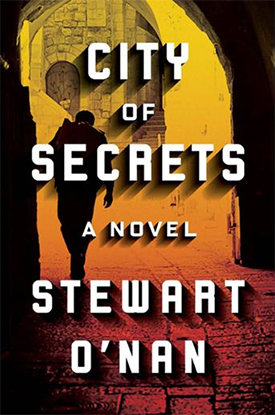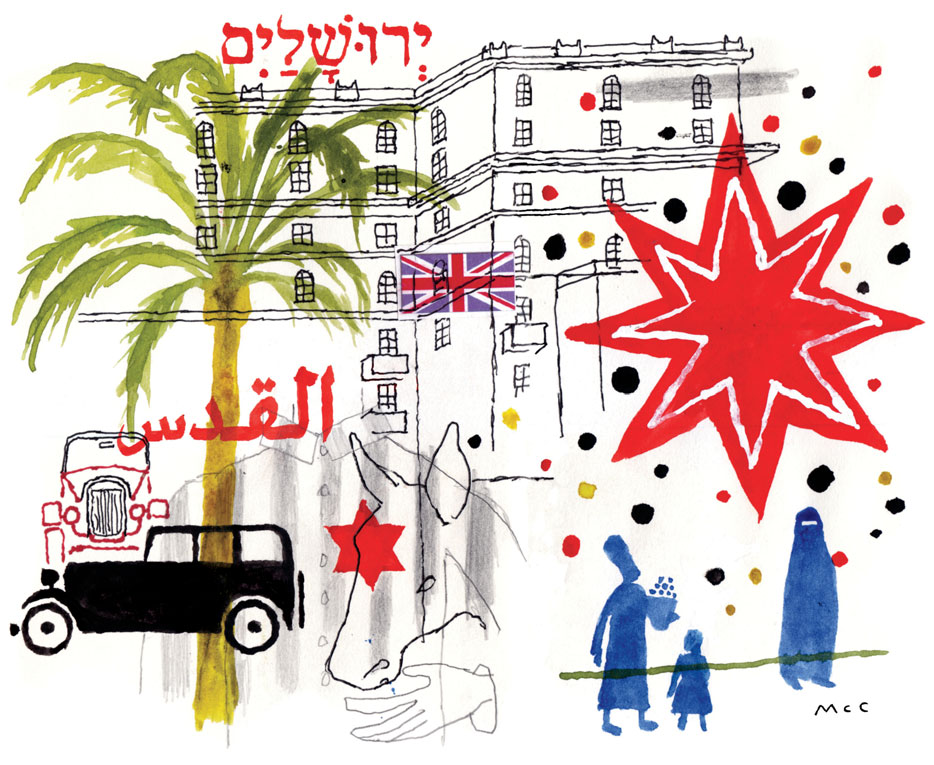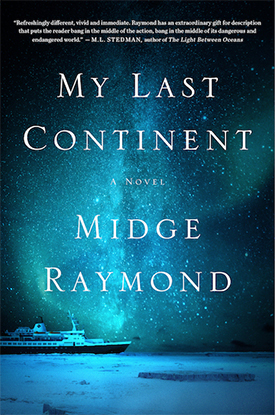Fiction
City of Secrets
Stewart O’Nan (ENG’83)
Viking
 O’Nan’s novels (Songs for the Missing, Emily Alone, Last Night at the Lobster) are striking for their range of tone and style. His last book was West of Sunset, a vividly drawn portrait of writer F. Scott Fitzgerald’s final years in Hollywood.
O’Nan’s novels (Songs for the Missing, Emily Alone, Last Night at the Lobster) are striking for their range of tone and style. His last book was West of Sunset, a vividly drawn portrait of writer F. Scott Fitzgerald’s final years in Hollywood.
His new novel, City of Secrets, is one of his most atmospheric. Set in Palestine in 1946, it’s the story of Jossi Brand, a Latvian Jew who has immigrated illegally to Palestine after surviving a concentration camp. Like thousands of other Jewish refugees in Palestine, he relies on the underground to shield him, joining a cell of the Haganah, a resistance group determined to end the British Mandate, which had capped the number of Jewish refugees allowed to enter Palestine at 75,000 over a five-year period, beginning in 1939.
In Brand, O’Nan has created a man plagued by survivor’s guilt, unable to forget the past, beset by “the question of what to do with his old life, memory seething inside him like a disease.” His burgeoning relationship with Eva, another member of the resistance group, offers some measure of comfort in a life he sees as “a shambles and a sham,” but he remains aloof and furtive. He arrives in Jerusalem determined to reclaim himself, to become, in his words, “a man again,” a task that proves considerably more complicated than he had reckoned.
Brand is given a new identity by the cell. By day, he works as a cab driver, shuttling tourists around Jerusalem. At night, he works as a courier, drawn into a deepening web of violence that culminates in the bombing of the King David Hotel, the home of the British government’s headquarters in Palestine—an actual event that occurred in July 1946.

Illustration by Adam McCauley
O’Nan beautifully evokes the dichotomy of a Jerusalem in flux just prior to the formation of Israel. He describes the city as “a puzzle box built of symbols, a confusion of old and new, armored cars and donkeys in the streets, Bedouins and bankers. The Turks and Haredim, the showy Greek and Russian processions—everyone seemed to be in costume, reenacting the miraculous past.” Jerusalem is presented as a city of roadblocks and curfews where nothing is what it appears to be. City of Secrets bears more than a passing resemblance to the novels of Graham Greene and John le Carré.
The suspense mounts as the cell’s acts of terrorism designed to thwart the British become increasingly brazen. As the novel builds to its denouement, the reader feels a sense of dread. It is a testament to O’Nan’s skills as a storyteller that he can imbue a 70-year-old event—the King David Hotel bombing—with such a sense of immediacy that it reads as though it happened yesterday. As the bombs explode, he describes in harrowing detail the swelling and trembling of the face of the hotel’s south wing, “its skin splitting, cracks spewing white puffs of dust, like a dam about to burst…with a roar, the front of the building buckled, slumped, then plunged to the ground, a shuddering avalanche exposing, for a moment, like a dollhouse, the rooms beneath.”
Writing with his customary compassion and sympathy, O’Nan ends on a grace note. The reader is left with a sense that Brand has finally been able to leave the past behind, that a future beckons. It’s a fitting end, made all the sweeter because it was won at such cost.—John O’Rourke
My Last Continent
Midge Raymond (COM’95)
Scribner
 Set on and around Antarctica, Raymond’s novel is a naturalist’s journal and travelogue as well as a thriller. From the shock of the frigid air to the feel of the fickle ice underfoot, her descriptions of the bottom of the world are so sharp and so visceral that one of the book’s main characters is the landscape itself. Full of mesmerizing beauty and malevolent mood swings, it sparkles, it heaves, it groans, it seduces.
Set on and around Antarctica, Raymond’s novel is a naturalist’s journal and travelogue as well as a thriller. From the shock of the frigid air to the feel of the fickle ice underfoot, her descriptions of the bottom of the world are so sharp and so visceral that one of the book’s main characters is the landscape itself. Full of mesmerizing beauty and malevolent mood swings, it sparkles, it heaves, it groans, it seduces.
The shape-shifting vagaries of nature on the South Pole are central to the narrative’s story line, which jumps around in time and involves events leading up to a deadly shipwreck.
The catastrophic wreck is revealed in the opening pages in a preface titled “Afterwards,” but portents are meted out over the ensuing chapters, each titled, like a ship’s log, with geographic coordinates as well as the years, weeks, days, and hours—not in chronological order—that remain before the catastrophe.
A major thread in this absorbing tapestry is a love affair between the narrator, a penguin researcher named Deb, and the self-taught naturalist Keller, who, like many before him, has sought employment in the world’s most inhospitable place in the hope of shedding the pain of a deep personal loss. In this frozen desert, the on-again, off-again pair are joined by a cast of largely self-absorbed scientists and hapless tourists, passengers on a ship of a cruise line that, in a not unlikely devil’s bargain, supports the travel to the South Pole of foundation researchers by employing them as guides. Mostly blameless and largely clueless, the luxury travelers on board are the type who feel invincible as they cross continents off their bucket list and fail, at their peril, to respect the lethal potential of their surroundings.
And then there are the penguins. Raymond’s obvious love and admiration for these creatures has the book veering, on occasion, toward a climate-change polemic, but when it comes to penguins, even the science is charming and poignant. (They are loyal mates who perpetuate their species with, if we may anthropomorphize, stunning self-sacrifice.)
Readers will come away from the book with a clear sense of the penguin colonies’ rhythms and struggles. And we understand what drew Deb to this harsh place: “In the summer, Antarctic sunsets last forever. The sky surrenders to an overnight dusk, a grayish light that dims around midnight…I hear the splatter of penguins bathing in their slush, the barely perceptible pats of their webbed feet on the rocks.” Thanks to her assured prose, we can envision the chinstraps, the gentoos, the Adélies and delight in the similes and metaphors they provide. “I notice,” she writes of the tourists, “how these visitors—stuffed into oversize, puffy red parkas—walk like the penguins themselves: eyes to the snowy ground, arms out for balance.”
Deep into the narrative Deb reflects on how she, too, is like a penguin: “I see my own life in theirs: a constant back-and-forth motion, always ending up where I started and circling back again—focused and simple—and perhaps this is why I chose this life, for the straightforward beauty I’m witnessing right now.” That penguin-like resiliency will serve Deb well as the book hurtles toward a devastating loss, and events that have her, perhaps for the first time, pointed irrevocably toward the future.—Susan Seligson
Book Briefs
Dogs, Murder, Teen Stars

Illustration by Flavio Morais
As any traveler to India or Mexico knows, the dogs that graze the garbage dumps and snooze along the road’s edge there are a far cry from the suburban American labradoodle that frolics under supervision at doggie day care. In fact, our beloved, often coddled companions reflect just a quarter of the planet’s canine population. It’s the other dogs, the millions of free-breeding, self-domesticated scavengers, that populate What Is a Dog? (University of Chicago Press, 2016) by Raymond Coppinger (CAS’59) and Lorna Coppinger (CAS’58). Biologists and science writers, they have traveled the world for four decades exploring the natural history, behavior, and startling adaptability of feral dogs.
Whether you believe her story or not, Lisa Michelle Lambert (MET’11), a BU Prison Education Program graduate serving a life sentence at the Massachusetts Correctional Institution–Framingham, has written a gripping book about her travails, titled Love, Murder, and Corruption in Lancaster County (Camino Books, 2016). Convicted in 1992, at age 19 (and pregnant nearly to term), for the stabbing murder of a 16-year-old acquaintance, Lambert had her conviction overturned in 1997, but landed back in prison the following year after a higher court reversed the overturn. Written with Philadelphia attorney David Brown, the book paints a tragic picture of an emotionally scarred young woman who was battered by her boyfriend, framed, she says, for a crime she tried to stop, and later repeatedly sexually assaulted by a prison guard. Brown, who researched Lambert’s case extensively, helps lay out the case for her abuse at the hands of the justice system as well.
The protagonist of Unscripted Joss Byrd (Roaring Brook Press, 2016) by Lygia Day Peñaflor (SED’95) is painfully familiar in a predatory popular culture that stalks and exploits teen stars. Despite their swagger, they are in many ways unformed, and like the secretly dyslexic, easily manipulated, acutely pubescent Joss, often struggle to make peace with their public and private selves. The author, a private tutor for teen movie actors, knows the territory intimately. Although the novel is classified as young adult, the likable, quick-on-the-uptake Joss is a character readers of all ages will root for.—SS















































 Set on and around Antarctica,
Set on and around Antarctica, 
Related Stories
Five Famous Alums: Writers
Pulitzer winners and best sellers
Sigrid Nunez Wins Top Literature Honor
CAS lecturer’s novel The Friend receives National Book Award for best fiction
War’s Mental Scars
Alum, COM prof team up to publish graphic novel
Post Your Comment